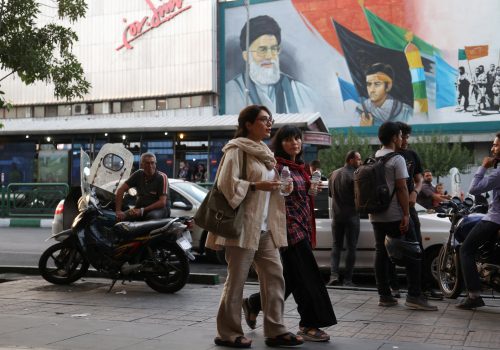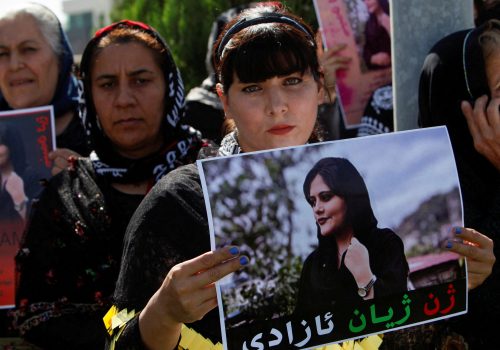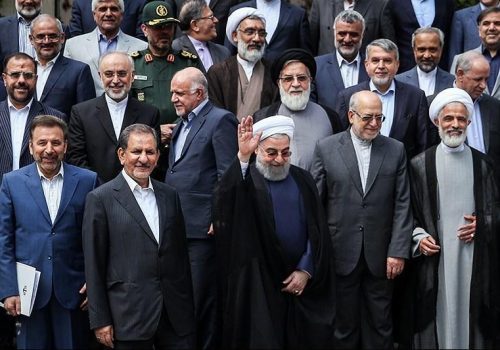The protests in Iran are not a revolution—yet. These events must occur first.
The Islamic Republic and Woman, Life, Freedom protestors are about to face off again a year after the death of Mahsa Jina Amini—a twenty-two-year-old Kurdish-Iranian woman who died in police custody after allegedly “violating” mandatory hijab—stirred hundreds of thousands to protest across all of Iran’s thirty-one provinces.
The ongoing protests inspired workers to strike and were only damped by severe repression, with hundreds of protestors killed and thousands arrested.
Today, the regime and protestors are in a struggle for the soul of the nation. The regime depicts the protestors as dangerous and treacherous rioters whom the West has manipulated in a plot to destabilize Iran. They are accused of planning one-year anniversary protests not simply to commemorate Amini, but to use demonstrations to undermine and disrupt the March 2024 parliamentary elections. That, the regime claims, is their real goal.
The protestors, in contrast, claim to be expressing the authentic will and voice of the Iranian people, who are tired of the unfair repression of women, the intrusive and petty “morality police,” and the strained, warped economy driven by hostility to the West, with only the military, clerical leaders, and their cronies benefiting.
The question is whether a new round of protests could, this time, prove a real threat to the regime, leading to a revolution and regime change, as happened in Tunisia in 2010 and Egypt in 2011. It’s unlikely, given the asymmetry in organization and clear leadership between the government and the protestors. However, events and actions by both sides could still lead to a revolutionary outcome.
The regime has mainly the Islamic Revolutionary Guard Corps (IRGC) and its Basij militia on its side, which are well-organized, well-funded, and, so far, willing to be ruthless in their support of the regime. The protestors have mainly young and urban women on theirs.
Though they have been enormously brave and creative in using social media and have evoked widespread sympathy, the protests have no clear leader, are weakly organized, and tend to vacillate in their goals. These have ranged from improving respect and freedom for women, especially stopping their harassment for dress code infractions, to broader efforts to change the regime and even to restore the leadership of the Pahlavi family through former Crown Prince Reza Pahlavi.
As an expected new round of protests approaches, the Islamic Republic has been extremely proactive in seeking to limit it. The regime has arrested women it has identified as “activists,” as well as a pop singer for releasing a song calling for women to wear their hair uncovered. Protesters continue to be given long prison sentences for their involvement and families of slain protesters are being arrested ahead of the anniversary.
Somewhat more surprising is the regime’s determination to double down on the cause of the protests, announcing that headscarf rules will become stricter and even more rigorously enforced.
In mid-2022 and earlier this year, as the regime focused its efforts on battling protestors who had taken to the streets, it withdrew the morality police from most neighborhoods. Women all over the country, especially in the major cities, began wearing their hijabs more loosely or not at all, while athletes and musicians publicly advocated standing up for women. Although all direct attacks on the government had been suppressed, it seemed that one positive outcome had arisen from the protests: women were going to defy the headscarf ban in such numbers so as to make a return to strict enforcement impossible.
Yet, starting in August, the regime has been signaling an intent to halt such defiance. A new bill being considered sets out harsh punishments, including hefty fines and imprisonment, for women not abiding by mandatory hijab. It even plans to fine businesses that allow improperly attired women on their premises. The bill also mandates a return to broader gender segregation in universities and other public spaces. These threats of stricter and more punitive enforcement risk fanning the flames of anti-regime anger that the government hoped to tamp down.
At present, the ties between the clerical leadership and the military are strong. For reasons of economic interest and nationalistic fervor, the military strongly supports the leadership of Supreme Leader Ayatollah Ali Khamenei. It would likely take some shocking action by the clerical establishment to persuade military leaders and its Basij foot soldiers that the regime is no longer ruling in the nation’s interests. That might be a sudden revelation of corruption on a wholly unexpected scale. Or it might be a leadership crisis if Khamenei dies without a clear successor, producing a power struggle at the regime’s core. Or perhaps it might be a choice of a successor to Khamenei who is too extreme or too unskilled to maintain the military’s loyalty.
Any such event or action that shakes the military’s confidence in the existing leadership and leads it to believe that protecting the regime is no longer in the nation’s best interest—nor their own—could open the way for a new leader with a different outlook to emerge. That could be from within the parliament or government structure, or perhaps someone from the outside who rises to the head of popular support.
A second potential turning point is how the regime handles the coming parliamentary elections in March 2024. Despite the power of the Supreme Leader, Iran has always been able to channel and moderate political conflict through its elections, which—even with the Guardian Council’s control over candidates and questions about vote counting—have nonetheless been open and competitive enough to produce a range of outcomes. In the past, Iran has elected a pro-business president, Ali Akbar Hashemi Rafsanjani (1989-1997); a reform-minded president, Mohammad Khatami (1997-2005); a populist president, Mahmoud Ahmadinejad (2005-2013); and a more diplomatic president, Hassan Rouhani (2013-2021) (several of them being surprise winners at the time).
Only in the 2021 presidential election did a true hardliner, President Ebrahim Raisi, win the presidency—in an engineered election guaranteeing his victory, to boot. Yet the landslide victory of Raisi, which happened with the lowest turnout in the Islamic Republic’s history, has raised questions as to whether future elections will provide the people of Iran with a voice in their government or simply be used by hardliners to pack the government with supporters. The looming parliamentary elections are a crucial test.
In August, the government announced that a record number of people had registered to become election candidates: almost forty-nine thousand. This is over three times as many as in the last election in 2020. Clearly, Iranians want to use parliament to impact policy. Yet, every candidate must be approved by the Guardian Council, a vetting body, which will announce their list of approved candidates in late October. A diverse list that includes a substantial number of reform candidates could divert popular energies from protests to campaigning for those candidates. However, a list that excludes most reformers and is overwhelmingly composed of hardliner candidates—as seen in the 2020 and 2021 elections—may elicit even greater protests, as that would suggest to many that the electoral process can no longer be used to influence the government or truly represent the Iranian people.
A third critical factor is whether the protests can expand their reach and provide a more compelling alternative to the current regime. While the protests drew on the enthusiasm of Iranian youth, the country is no longer as young as it once was. The birthrate fell in the wake of the Islamic revolution, dropping rapidly from almost six children per woman to just two today. As a result, the cohort of young people in their twenties is substantially smaller than the larger cohorts who are aged thirty to forty-five. This larger group—concerned for their jobs, families, and future—must be persuaded to risk protest. For that to occur, they must be convinced that the protestors have a plausible and compelling alternative to offer. Currently, the protests have a martyr in Amini, but they lack a leader with national visibility and stature.
Even in exile or prison, leaders like Vladimir Lenin, Fidel Castro, Nelson Mandela, and even Ayatollah Ruhollah Khomeini became known as dedicated champions of change who established themselves as national leaders through their writings, speeches, and sacrifices. There were no similar leaders in Tunisia and Egypt, but established organizations took that role with large followings. In Tunisia, it was the professional associations and unions of lawyers, teachers, and workers, while it was the Muslim Brotherhood in Egypt. Without such well-organized and broadly supported groups at their head, these protests would likely not have succeeded in forcing out their rulers. To draw in the majority of Iranians, the protests need to have a leader or organization that people trust—one that offers an attractive alternative to the current leadership.
Finally, it remains to be seen whether the regime makes self-defeating decisions. It may be that the draconian new bill on hijab enforcement is toned down before it passes and is not enforced in such a way as to antagonize businesses and ordinary Iranians. But, if the regime truly follows through on its threats to create a surveillance state that punishes everyone in sight, including businesses with customers on the premises who do not conform to the regime’s Islamic ideal, then it may drive more and more Iranians into the opposition.
Economic grievances are another factor that provided fuel for the protests. It now seems that Iran’s dismal economy is improving slightly. Increased trade with China and Russia and possible gains from Iran’s inclusion in the newly expanded BRICS offer new prospects. Yet, if China or Russia suffers an economic meltdown that pulls down Iran, or if there is a new bout of runaway inflation, or Tehran’s aggression in the Persian Gulf or elsewhere spurs greater sanctions, then the regime may be seen as having undermined the economy, which may cost it popular support.
The current balance of power still favors Khamenei; a loyal military gives his regime the upper hand over weakly organized protestors that mobilize only a portion of Iran’s people. But revolutions are, by their nature, unpredictable. If a revolution should ever arise in the Islamic Republic, it will be because the regime has managed to alienate the military and antagonize the population. At the same time, protestors would have assembled a stronger organization and compelling leadership. Events in the next few months—the scale of the anniversary protests, the ferocity of the regime’s new hijab policies, and the screening of candidates for the parliamentary elections—will all bear watching. How the regime handles these issues will signal whether Iran is headed for greater confrontation and instability.
Jack A. Goldstone is the Virginia E. and John T. Hazel Jr. professor of public policy at George Mason University and a global policy fellow at the Woodrow Wilson Center. He is the author of Revolution and Rebellion in the Early Modern World and Revolutions: A Very Short Introduction.
Further reading
Tue, Aug 15, 2023
Women in Iran fight to break Islamic Republic ‘cage’
IranSource By Khosro Sayeh Isfahani
“I will not return to that cage. I will not bow before bondage.”
Wed, Sep 6, 2023
A pilgrimage of love: Mourning the dead in defiance of the Islamic Republic
IranSource By
Over the past weeks, the Islamic Republic has harassed, threatened, detained, and exiled relatives of the victims of state violence.
Thu, Oct 10, 2019
Don’t expect regime change in Iran
IranSource By
There are half a dozen reasons why the Islamic Republic has been so resilient in the face of extraordinary internal and external pressures.
Image: People take part in a protest following the death of Mahsa Amini, near the Iranian consulate in Istanbul, Turkey October 4, 2022. REUTERS/Murad Sezer


